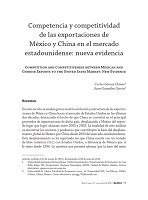Competition and Competitiveness between Mexican and Chinese Exports to the United Sates Market: New Evidence
DOI:
https://doi.org/10.32870/mycp.v6i16.522Keywords:
Commercial Displacement, Economic Sectors, Revealed Comparative Advantages, Market, Exports.Abstract
The following text analyzes grosso modo the evolution and structure of Mexican and Chinese exports to the United States’ market during the last two decades, with special attention paid to the fact that China became the principal provider of exports to the United States market. Resulting in Mexico being displaced from the second place it had achieved during the period 2000-2002. The objective of this investigation is to discover which sectors and products are involved in said displacement of Mexico by China. In addition, this took place even though China has no free trade agreement with the United States, as in the case of Mexico, that has one since 1994. This situation allows us to conclude that China’s success is due to certain visible comparative advantages, which have reacted more favorably to the dynamic changes that are taking place in international trade at this moment throughout the world. We have used Balassa’s Specialization Index in order to prove our hypothesis in relation to Mexico’s displacement by China, but also show, at the same time, that despite China’s gains from 2001 on in certain sectors and its position as the most important supplier to the United States’ market since 2003. Mexico has managed to lessen that disadvantage during the last few years, and that this tendency could continue until the end of the present decade; a situation that in the short term will result in its recuperation as far as participation in the United States’ market is concerned.Downloads
References
Atkinson, Robert D. (2013). Competitiveness, Innovation and Productivity: Clearing up the Confusion. The Information Technology & Innovation Foundation.
Augustine, Peter. (2009). Competition and Competitiveness: Issues and Challenges and Role of Competition Law. http://www.cci.gov.in/sites/default/files/speeches/keynote_add_20090304164450.pdf. Consultado el 6 de julio de 2016.
Bureau of Statistical of State (bss). (2015). China Statistical Yearbook 2015.Beijing, China: China Statistics Press.
Cabranes, Flora. (2011). “Exportaciones chinas y mexicanas hacia Estados Unidos: ¿Sigue China afectando a México?”, Papeles de Europa, núm. 22, pp. 197-225.
Cámara Argentina de Comercio (cac). (2015). Informe económico: República Popular China. Buenos Aires, Argentina: Observatorio de Comercio Exterior, pp. 1-20.
Cepal. (2015). Balance preliminar 2015 de las economías de América Latina y el Caribe. Santiago, Chile: Comisión Económica para América Latina y el Caribe.
Dent, M. Christopher. (2013). “Paths Ahead for East Asia and Asia Pacific Regionalism”, International Affairs, 89(4): pp. 963-985.
Durán Lima, José, y Andrea Pellandra, A. (2013). “El efecto de la emergencia de China sobre la producción y el comercio en América Latina y el Caribe”, en: Dussel Peters, Enrique (Coord.), América Latina y el Caribe-China. Economía, comercio e inversiones. México: udual.
Durán Lima, José, y Mariano Álvarez, M. (2011). Manual de comercio exterior y política comercial. Nociones básicas, clasificaciones e indicadores de posición y dinamismo. Santiago de Chile: cepal.
Dussel Peters, Enrique, y Kevin P. Gallagher, K. (2013). “El huésped no invitado del tlcan: China y la desintegración del comercio en América del Norte”, Revista de la cepal, núm. 110, agosto, pp. 85-111.
Esquivel, Gerardo. (2014).“El tlcan: 20 años de claroscuros”, Foreign Affairs Latinoamérica, 14(2): 7-16. Consultado el 15/01/2016 en http://revistafal.com/el-tlcan-20-años-de-claroscuros-2/Ezeala-Harrison, Fidelis. (1999).
Theory and Policy of International Competitiveness. Westport, Estados Unidos: Praeger Publishers.
Fondo Monetario Internacional (fmi). (2015). World Economic Outlook. Adjusting to Lower Commodity Prices. Washington, dc: Fondo Monetario Internacional.
Gandolfo, Giancarlo. (2014). International Trade Theory and Policy. Berlín: Springer-Verlag.
Hernández Hernández, Roberto. (2006).“Las relaciones comerciales entre China y Estados Unidos. El comercio de bienes industriales y agrícolas: Implicaciones para México”, México y la Cuenca del Pacífico, 9(27): 25-39.
Ibarra Puig, Vidal. (2014). México a 20 años del tlc: ¿Integración o dependencia?, Comercio Exterior, 64(6): pp. 46-62.
Jinjing, L., y Zhixiao, Zheng. (2015). “The Economic Link between China and North America”, The Antitrust Bulletin, 60(1): 40-45.
Krugman, Paul. (1997). El internacionalismo moderno. La economía internacional y las mentiras de la competitividad. Barcelona: Crítica.
Lardy, Nicholas R. (2010). “The Sustainability of China’s Recovery of the Global Recession”, Policy Brief, núm. PB10-7, pp. 1-8. Washington, dc: Peterson Institute for International Economics.
Melnyk, O., y Yaskal, I. (2013). “Theoretical approaches to concept of ‘com-petition’ and ‘competitiveness’, Ecoforum, 2(2): 8-12.
Morrison, M. Wayne. (2015). “China’s Economic Rise: History, Trends, Challenges, and Implications for the Unites States”, crs Report.Washington, dc: Congressional Research Services.
OCDE. (2015). Economic Surveys. China. Overview. Recuperado de: http://www.oecd.org/eco/surveys/China-2015-overview.pdf
OMC. (1995). Estadísticas del comercio internacional 1994. Ginebra, Suiza: Organización Mundial del Comercio.
OMC. (1996). Estadísticas del comercio internacional 1995. Ginebra, Suiza: Organización Mundial del Comercio.
OMC. (2002). Estadísticas del comercio internacional 2001. Ginebra, Suiza: Organización Mundial del Comercio.
OMC. (2003). Estadísticas del comercio internacional 2002. Ginebra, Suiza: Organización Mundial del Comercio.
OMC. (2004). Estadísticas del comercio internacional 2003. Ginebra, Suiza: Organización Mundial del Comercio.
OMC. (2006). Estadísticas del comercio internacional 2005. Ginebra, Suiza: Organización Mundial del Comercio.
OMC. (2007). Estadísticas del comercio internacional 2006. Ginebra, Suiza: Organización Mundial del Comercio.
OMC. (2008). Estadísticas del comercio internacional 2007. Ginebra, Suiza: Organización Mundial del Comercio.
OMC. (2009). Estadísticas del comercio internacional 2008. Ginebra, Suiza: Organización Mundial del Comercio.
OMC. (2010). Estadísticas del comercio internacional 2009. Ginebra, Suiza: Organización Mundial del Comercio.
OMC. (2011). Estadísticas del comercio internacional 2010. Ginebra, Suiza: Organización Mundial del Comercio.
OMC. (2012). Estadísticas del comercio internacional 2011. Ginebra, Suiza: Organización Mundial del Comercio.
OMC. (2013). Estadísticas del comercio internacional 2012. Ginebra, Suiza: Organización Mundial del Comercio.
OMC. (2014). Estadísticas del comercio internacional 2013. Ginebra, Suiza: Organización Mundial del Comercio.
OMC. (2015). Estadísticas del comercio internacional 2014. Ginebra, Suiza: Organización Mundial del Comercio.
OMC. (2016). Tendencias del comercio mundial en 2015. Ginebra, Suiza: Organización Mundial del Comercio.
Organización de las Naciones Unidas. (s/f). Base de datos Comtrade. http://comtrade.un.org/data/. Consultada el 7 de noviembre de 2015.
Porter, Michael E. (1990). Competitive Advantage of Nations. Nueva York: Free Press, pp. xx-855.
Siggel, Eckhard. (2006). “International competitiveness and comparative advantage: A survey and a proposal of measurement”, Journal of Industry, Competition and Trade, 6(2), junio, pp. 137-159.
Stigler, George. (1974). “Competencia”, en: Sills, David L. (Dir.), Enciclopedia internacional de las ciencias sociales. Madrid, España: Aguilar.
Subasi, Erketing Merik, Yuce, Dural, y Yetul, B. (2015).“Sustainable Economic Growth with wto Accession of China”, Electronic Journal of Social Sciences, 14(53): 88-103.
United States Census Bureau. (s/f). http://censtats.census.gov/cgi-bin/sitc/sitcCty.pl. Consultado el 4 de noviembre de 2015.
Villarreal, M. Ángeles, y Fergusson, I. F. (2014). “Nafta at 20: Overview and Trade Effects”, crs Report, núm. R42965, abril. Congressional Research Service.
Womack, Brantly. (2013). “Beyond win win: Rethinking China’s international relationship in an era of economic uncertainty”, International Affairs, 89(4): 911-928.
Yifu Lin, Justin, Hin T., Ding, e Im, Fernando. (2010). “us-China External Imbalance and the Global Financial Crises”, China Economic Journal, 3(1): 1-37.
Yifu Lin, Justin. (2011). Demystifying the Chinese Economy. Cambridge, Reino Unido: Cambridge University Press.

Downloads
Published
Issue
Section
License
Open Access Policy
This journal provides open access to all its contents, in adherence to the principle that making research freely available supports a greater global exchange of knowledge.
MyCP is licensed under a Creative Commons Attribution-NonCommercial license, also known as CC BY-NC.
Contents are published in both PDF and XML formats.
Authors who publish in México y la Cuenca del Pacífico must accept the following conditions:
Pursuant to Mexican copyright laws, México y la Cuenca del Pacífico acknowledges and respects the authors’ moral right and ownership of property rights, which will be assigned to the University of Guadalajara to publish the articles in an open-access mode.
México y la Cuenca del Pacífico does not charge the authors any fees for receiving and processing their articles.
Authors are permitted to enter into other independent and additional contractual agreements for the non-exclusive distribution of the article version published in México y la Cuenca del Pacífico (for example, publishing it in an institutional repository or in other printed or electronic media) as long as they clearly state that the piece was originally published in México y la Cuenca del Pacífico.
Pursuant to the above, once the article is approved for publication, authors must send the Assignment of Rights Agreement form duly filled and signed. This form must be sent to mexicoylacuenca@gmail.com as a PDF file.
Readers/users of México y la Cuenca del Pacífico can freely access the journal new issues as soon as they are uploaded. Readers/users are allowed to cite, share (both electronically and physically), print and distribute the material, provided they expressly state that the work was originally published in México y la Cuenca del Pacífico. Contents are to be properly cited and never for commercial purposes.




